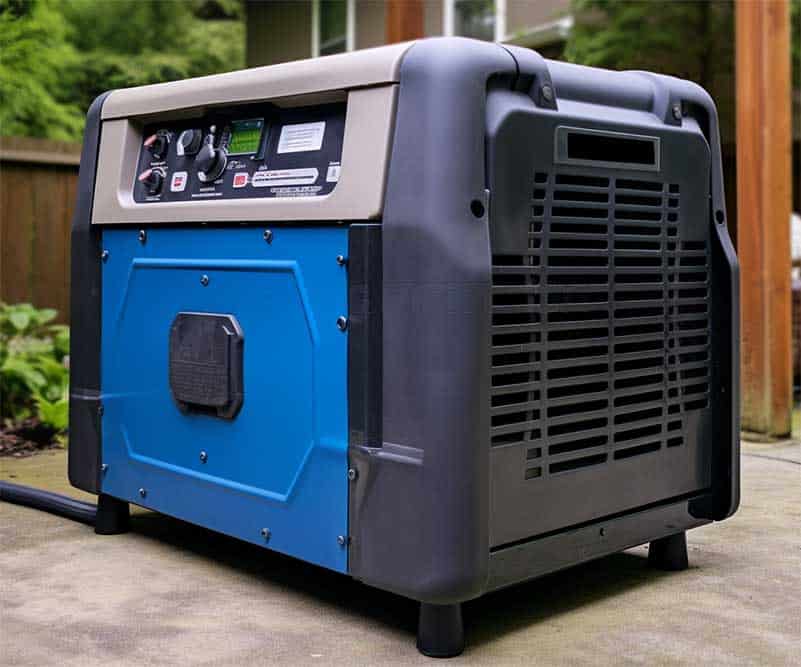Installing Residential Standby and Portable Generators

Standby and Portable Generators: They Make a Big Difference During Catastrophic Weather Events
As electricians in San Antonio, All Star Electric has been installing standby and portable generators in homes for decades. But the number of installations drastically increased after the catastrophic events of February 2021.
The “Big Freeze”, as we call it, took everybody by surprise. Temperatures across Texas dropped suddenly, and the extreme weather forced Texans to draw more power than usual to keep their home at temperature. The massive draw overpowered the grid and took down large sections of it: over 4.5 million homes and businesses lost power, some for days, causing at least 210 deaths. Water infrastructure was also compromised: 14+ million residents received boil-water notices due to low water pressure and broken pipes. The Texan economy took a big hit, with the cost of the disaster estimated to $195 billion.
San Antonio and Bexar County were directly impacted. Hence the sudden rise in demand for backup generators, both standby and portable, in our region.
Key takeaways
- This guide provides a fairly comprehensive examination of various generator types designed for residential use.
- We offer a view of what the optimal generator size would be depending on what you need to power during an outage.
- Generators range from portable units (good for temporary relief) to standby models (a perpetual solution).
- The factors determining your choice will be energy efficiency, output capacity, specific power requirements, and budget.
- We did 2 comparisons (brand-to-brand and unit-to-unit) to show important technical specifications to pay attention to.
- Both types of units require maintenance to keep operating at factory specifications.
Things to Consider When Choosing a Generator

The very first aspect to consider when selecting a power generator is what is to be backed up when power goes out. Generators vary in size and type, so what you need to have available during an outage will determine your choice of size.
Then you want to consider the available fuel sources.
The third component of your choice is the connection point to your power utility company. To transfer power from the generator to your home (when the main power source of your home fails) you need a transfer switch. This switch has several functions:
- Isolating the generator from the utility power, thereby preventing the generator to feed electricity back into the utility lines.
- Detecting the power loss and, if automatic (ATS), starting the generator and switching the electrical load to the generator. A manual transfer switch requires you to start your generator.
- Managing power distribution to critical circuits (heating, cooling, and refrigeration) or to the entire electrical panel.
The transfer switch ensures you can’t connect the generator to “live” electrical components from your utility power. As long as there is power in the grid, your generator won’t start.
The fourth component of your decision is the generator power inlet receptacle: this device connects your generator to the manual transfer switch. This outlet must be sized properly for your generator. The connection must be secure, and all wiring must be correctly installed. By the same token, the section of the cable connecting your generator to the power inlet will be determined by the size of your generator.
Do You Need a Licensed Electrician to Do the Job?
Texas law does not explicitly mandate the hiring of a licensed electrician to install your backup generator. However, Texas Property Code Section 202.019 addresses standby electric generators, emphasizing compliance with manufacturer’s specifications and applicable governmental health, safety, electrical, and building codes.
In practical terms, there are many reasons why you will need to hire a licensed electrician (and a reliable one to boot!)
- You will need a permit from the City of San Antonio, and to notify your electric utility.
- To install the proper transfer switch, you will need to have the power company pull the electric meter to disconnect from the system. That requires breaking the seal.
- Whole-house generators are heavy, difficult to move and require a fuel source. If your generator is gas powered (natural or propane), those connections need to be made and tested by a certified gas technician.
- Once the installation and wiring are complete, the job must be inspected before the utility power is reconnected.
Most homeowners do not have the knowledge and equipment necessary to do this themselves. Moreover, the process starts with doing load calculations and examining your service panel to determine the size of your generator and how it will be hooked up to your panel.
The licensed electricians of All Star Electric San Antonio have mastered the installation process of backup generators, whether standby or portable. We get the job done right the first time. We give you the expert advice you need to determine the size and type of generator best adapted to your circumstances, and we will deliver a timely and affordable service. (For reference: 4 Factors Determining How to Choose Your Electrician)
Selecting and Prepping the Power Generator Installation Site

The site on which your power generator is to be installed must balance safety, operational efficiency, and accessibility. We begin by surveying your property to pinpoint a location that offers ample space for maintenance and enough distance from living areas to mitigate noise interference.
This site must also receive enough airflow to allow exhaust fumes to dissipate safely, away from windows, vent intakes, and enclosed spaces.
We will advise you on all possible locations, and you will make your choice. Once the area is selected, we will prepare the site by clearing any debris, vegetation, or obstructions. We need to create a clean working area. We also need to ensure the ground is level: the generator needs a stable, even base that prevents vibration and movement affecting its operation. This typically requires compacting the soil or laying a concrete pad. A concrete pad isolates more effectively the bottom of your unit from the humidity of the ground and from settling issues later on.
Site Preparation Steps
- Clear the Site: Remove all potential obstructions to create a clutter-free environment.
- Level the Ground: Confirm the site is flat and sturdy enough to support the weight of the generator.
- Accessibility: Must guarantee easy access for installation and maintenance crew.
- Safety Distance: Must maintain manufacturer’s recommended clearances from buildings and other structures.
In addition, the location of choice must be within a reasonable distance from the fuel supply (natural gas line or diesel fuel storage area) for straightforward connections and refueling operations.
And the installation site needs to adhere to local codes or regulations, considering setback requirements and noise ordinances (Texas Property Code Section 202.019).
Remember, the selected site impacts not only the initial installation process, but also the long-term operation and maintenance of your power generator. We will make sure the location conforms to the applicable standards of safety and functionality.
Fuel Source Options
What fuel source should you select? Your choice impacts the efficiency and the cost of your power generator, as well as the complexity of the installation process. Let’s review the fuel types, their benefits and their limitations.
Gasoline-Powered Generators
Gasoline is readily available fuel, it is convenient. It is highly volatile, which involves safety concerns and impacts storage life. And over time, gasoline prices have trended up.

Diesel-Powered Generators
Diesel engines are durable and efficient. Their higher energy density increases their longevity. Diesel fuel requires careful storage and prices have consistently risen over time.

Propane-Powered Generators
Propane burns clean and propane-powered generators are more silent. This gas has a long storage life with no degradation. However, it tends to be less accessible during widespread power outages and in remote areas.

Natural Gas-Powered Generators
- Advantages: The supply of natural gas is both consistent and reliable in many regions of Texas. This fuel burns clean and generators using natural gas require minimal storage space.
- Challenges: Installation requires a connection to a municipal gas line, which can be complex. It is also subject to local regulations.
In Texas, homeowners tend to make natural gas and propane their first choices of fuel for power generators.
In sum, your decision will have to be based on availability during emergencies, storage requirements, how often you plan to use the generator, and the cost of fuel. As you can see, each fuel type has trade-offs: the right choice for you must be based on your household’s needs and the location of your home.
Navigating Local Permits and Regulations
As licensed electricians in San Antonio, All Star Electric as a long experience in obtaining the necessary city permits and in dealing with utilities. We take over the entire process for you, so you don’t have to consult the city website and deal with the red tape at the building permits office.
Our electricians will provide the authorities with detailed design installation plans, power generator specifications, and as applicable, proof of compliance with zoning laws.
Our team will also deal with the utilities (connection with the grid, connection with gas lines), and attend the inspections for you.
Addressing Noise and Environmental Impact issues
In our experience, installing a power generator raises noise concerns and environmental issues. We will address both from the get-go to make this project successful. The central questions are how do we minimize noise levels, and how do we reduce the environmental footprint of your backup generator?
We all want to be good neighbors, respect our community and region, and remain within the boundaries of the law. Additionally, we want decibel levels to be as low as possible when the generator is on.
Minimizing Generator Noise

Generators, by their nature, are noisy. In residential areas, this is a major concern.
To keep your neighbors happy and comply with local noise ordinances, we will work on the following solutions:
- Installing acoustic barriers or enclosures specifically designed to dampen generator noise.
- Selecting a generator with lower decibel ratings. You will in the comparison below that the DuroMax generators are more silent than their counterparts. This is definitely an advantage that should be highlighted.
- Positioning your generator as far as possible from your windows and your neighbor’s windows, and direct the exhaust pipes away from your neighbor’s and your own home.
- Schedule regular maintenance with you to keep your generator running smoothly, and operational noise at a minimum.
Reducing Environmental Impact
All generators have an environmental impact: they burn fuel, and they emit gases. This is the advice we give homeowners:
- Favor generators with the latest emission control technologies to decrease harmful exhaust emissions.
- Consider fuel options with a lower environmental impact: biodiesel, natural gas.
- Implement an energy-efficient operation plan to run your generator only when necessary.
- Keep your generator maintained regularly to keep it operating at peak efficiency (conserving fuel and reducing emissions).
- Plan for proper disposal of used oils and batteries, following local regulations to prevent soil and water pollution.
- Consider the most silent generator models, as noise also impacts the environment.
Electrical Load Assessment
To select a power generator of the right size, we need to conduct an electrical load assessment of your home. We tally the wattage of all electrical devices that require power during an outage. This means that you will have to decide what you want to power up during an outage.
We begin by listing essential appliances: refrigerators, air conditioning, lights. Then, we consider the starting wattage required for devices with motors: well pumps, furnaces and air conditioners, workshop machinery if you run some.
Assessment List of Electrical Load

- Identifying all critical appliances and systems that need power during an outage.
- Noting “continuous running watts” and “additional starting wattage” for each device.
- Adding up total running watts to determine the running wattage capacity of the generator.
- Ensuring the generator can handle the highest starting wattage (peak wattage requirement).
We also need to factor in not just your current electrical demand, but also any planned home expansion and future potential increased usage. These measurements affect the long-term suitability of your power generator.
Hiring a San Antonio licensed electrician removes the risk of underestimating your electrical load. If this is of any interest to you, you can also access specific guidelines from the Texas Department of Licensing and Regulation at https://www.tdlr.texas.gov to read comprehensive information on state regulations concerning electrical assessments and generator installations.
Standby Generator or Portable Generator?
There are 3 main categories of generators: standby, portable, and continuous operation. Each type covers a specific spectrum of needs.
Standby Generators: A Safety Net for Power Outages
Standby generators remain idle until an interruption of your main power supply occurs. Then they spring to life, and start powering your essential appliances and systems. In our region, where power outages are relatively infrequent, this type is a good choice for homes when you want immediate backup power.
Main benefits
- Automatic Activation: Standby generators automatically turn on during a power loss, minimizing downtime.
- Fuel Efficiency: Because they operate only when needed, they are typically more fuel-efficient than other types of generators.
- Cost-Effective: they typically involve lower operational costs (maintenance, repair), which makes them a budget-friendly option in the long run.
Portable Generators: A Flexible Solution

Portable generators are versatile units that can be moved as needed, providing a convenient power source for a variety of situations. They are well-suited for very temporary power needs, such as outdoor events, construction sites, or as a backup for homes during infrequent (and relatively short) power outages.
- Mobility: You can easily move portable generators from one location to another.
- Versatility: They come in various sizes and power capacities. They will keep small appliances and parts of your household powered. They typically deliver less power than standby generators, which does not make them the right solution for big homes or when the homeowners want all parts of their home to remain fully operational during a power outage.
- Manual Operation: Unlike standby generators, portable generators typically require manual start-up (MTS). They won’t automatically kick in during a power outage but necessitate a physical presence to turn them on. If you are often taking trips and want your power generator to kick in in case of a power outage while you are away… this is not the right type of generator for you.
- Fuel Options: Most portable generators run on gasoline. Some models use diesel, propane. Some smaller models use solar power.
- Cost: Portable generators are generally less expensive to purchase than a standby or a continuous operation generator, and they require less maintenance. On the other hand, they tend to be less fuel-efficient, and over time the cost of fuel can outrun the difference in the cost of purchase.
Continuous Operation Generators: An Uninterrupted Power Source
There is a third type generators: the continuous operation generators (or “prime power generators”). They run non-stop to provide a steady flow of electricity. These units are well adapted to locations where the power grid is unreliable and to critical operations that can’t tolerate any power disruption.
- Reliable Power Supply: Designed to operate continuously, they generate power constantly.
- High-Performance: Built to withstand prolonged usage, reliable for essential services.
- Durability: These generators are robust and can handle the strain of constant use.
Hospitals are typical users of these generators. Critical care units use machinery and devices that require power 100% of the time. A continuous operation generator fits the needs of these operations.
We excluded this type of generators from this article, as we focus on residential use, rather than commercial situations.
When we advise you about the generator operation mode best fitting your needs, we take into account the frequency of power outages, the critical nature of uninterrupted or long-lasting power for your operations, the power capacity you want available during any outage of any length, and your budget for fuel and maintenance.
Portable Generators: Brands We Recommend
For portable generators, there are 3 brands we recommend after seeing them operating for years: Westinghouse, DuroMax, and Champion. All Star Electric San Antonio is a certified installer for DuroMax generator products, but if you prefer another brand, we will install it just as well.
Brand-to-Brand Comparison
Let’s do a short comparison between the 3 brands:
Westinghouse Portable Generators
- Westinghouse offers a range of portable generators with varying power outputs, from smaller models suitable for basic power needs, to more robust units capable of powering larger appliances and tools.
- Technical features include CO sensors for safety, dual fuel capabilities, and sound attenuating enclosures for quieter operation.
- Westinghouse generators have a good reputation for reliability, and you find them in both residential and commercial settings.
DuroMax Portable Generators
- DuroMax’s line of portable generators includes models that run on dual fuel and tri fuel (gasoline, propane and natural gas) and models with electric start capabilities.
- Some units come equipped with carbon monoxide detection, enhancing safety for users.
- DuroMax generators are versatile, catering to a wide range of uses from home backup to outdoor recreational activities.
Champion Portable Generators
- Champion provides portable generators ranging from 1200 watts to 12,000 watts, suitable for various applications like RV use, home backup, and project work.
- Champion generators claim to be user-friendly, with a focus on ease of operation and maintenance.
- They offer a balance of power and portability, making them a popular choice for a broad spectrum of users.
Unit-to-Unit Comparison
Here is a direct comparison of the DuroMax 16,000-Watt V-Twin Dual Fuel Portable Digital Inverter Generator, the Westinghouse WGen12000DFc Generator Dual Fuel with CO Sensor, and the Champion 12000 Watt Tri-Fuel Generator with CO Shield:

DuroMax 16,000-Watt V-Twin Dual Fuel Portable Digital Inverter Generator
- Fuel Types: Gasoline and Propane
- Starting/Running Power: Gasoline: 16,000 Watts peak, 13,000 Watts running; Propane: 15,200 Watts peak, 12,350 Watts running
- Noise Level: 66.9 dB
- Run Time: Gasoline: 18.2 hrs at 25% load, 10.5 hrs at 50% load; Propane: 11/16.5/27.75 hrs at 25% load, 6/9.4/14.5 hrs at 50% load (depending on tank size)
- Warranty: 5 Years
- CO Alert System: Yes

Westinghouse WGen12000DFc Generator Dual Fuel with CO Sensor
- Fuel Types: Gasoline and Propane
- Starting/Running Power: Gasoline: 15,000 Watts peak, 12,000 Watts running; Propane: 13,500 Watts peak, 10,800 Watts running
- Noise Level: 74 dBA
- Run Time: Gasoline: 11 hrs at 50% load; Propane: 7 hrs at 50% load
- Warranty: 3 Years (Residential), 1 Year (Commercial)
- CO Alert System: Yes

Champion 12000 Watt Tri-Fuel Generator with CO Shield
- Fuel Types: Natural Gas, Gasoline, Propane
- Starting/Running Power: Gasoline: 15,000 Watts starting, 12,000 Watts running; Propane: 13,750 Watts starting, 11,000 Watts running; Natural Gas: 12,500 Watts starting, 10,000 Watts running
- Noise Level: 78 dBA
- Run Time: Gasoline: 9 hrs at 50% load; Propane: 3.5 hrs at 50% load (20 lb tank)
- Warranty: 3 Years
- CO Alert System: Yes (CO Shield®)
Unit-to-Unit Comparison Summary
- Fuel Flexibility: In this comparison, the Champion generator stands out for its tri-fuel capability, offering the most versatility in fuel choice. Note: DuroMax also offers a tri fuel generator, but his specifications are so superior to the 2 other units that we excluded it from the comparison.
- Power Output: The DuroMax generator offers the highest starting and running power on gasoline.
- Noise Level: The DuroMax generator is the quietest among the three (67dB vs. 74 and 78 dBA).
- Run Time: The DuroMax generator provides the longest run time, especially on gasoline.
- Warranty: All three generators offer substantial warranty periods, with DuroMax providing the longest (5 years).
- CO Alert System: All three generators feature CO alert systems for safety.
All 3 units would serve their purpose well, and in our experience all 3 brands treat their customers right, with excellent pre- and post-sale customer service and great warranties. All Star Electric San Antonio being a certified installer of DuroMax products, you benefit from our own customer service as well, for extra peace of mind.
Standby Generators: A Brand We Recommend
The most ubiquitous of all standby generator brands for residential applications is Generac, a Wisconsin-based manufacturer. According to their website, they control 80% of the market, and indeed, we often see their units installed in single-family properties.
We can’t compare a standby generator directly to a portable generator because it would be comparing apples to oranges. Instead, we summarized the characteristics of one of their most sophisticated units: the Model #7291.
Generac Guardian Series 26kW Home Backup Generator (Model #7291)

- Power Output: Offers 26kW of power, capable of starting and running all large appliances in a home. It features a new alternator design producing 230LRA or 55.2kVA starting power.
- Compact Design: Despite its high-power output, the generator has a compact footprint, taking up to 68% less space compared to competitive output liquid-cooled products.
- Cost Efficiency: It offers potential savings of up to $8,000 in product and installation costs compared to similar liquid-cooled products.
- G-Force Engine: Equipped with Generac’s purpose-built G-Force Engine, designed for reliability and requiring less routine maintenance.
- True Power™ Technology: Delivers best-in-class power quality with less than 5 percent total harmonic distortion, ensuring smooth operation of sensitive electronics and appliances.
- Quiet-Test™ Self-Test Mode: Features a self-test mode that runs at a lower RPM for a quieter operation and less fuel consumption.
- Mobile Link™ Remote Monitoring: Enables monitoring of the unit status from anywhere in the world using a smartphone, tablet, or PC.
- 24/7 Customer Support: Generac provides round-the-clock customer support from their headquarters in Wisconsin.
- User-Friendly Controls: The Evolution™ Controller includes a multilingual LCD display for monitoring battery status and maintenance intervals.
- Durable Enclosures: The generator is housed in tough, all-aluminum enclosures with a RhinoCoat™ powder-coated finish for all-weather durability.
- Warranty: Comes with a 5-year limited warranty.
- Engineered and Built in the USA: Assembled in the USA using domestic and foreign parts.
- CO Sensor Shutdown: Features a carbon monoxide sensor with automatic shutdown for safety.
Standby Generators: You Need to Know This
As we mention in another section of our website discussing standby and portable generators, standby units are not for every household.
Some Pros
On the pro side, standby generators provide more power than portable generators, making them well-suited for the backup power needs of larger homes, and for homeowners who want to keep their home entirely powered during a prolonged power outage due to severe weather or natural disaster in all seasons (snow, hail, ice storms during winter; any heat wave, heavy wind and gales, heavy rain, flood events, tornadoes, and hurricanes during summer).
These backup generators typically run on natural gas, propane, or diesel and can provide up to 26,000 watts of power. This is more than enough to power up all your household appliances, to run your refrigeration systems (large homes often have multiple units storing frozen food) and your entire HVAC system (heating, ventilation, and air conditioning), and to keep all your lights on — as long as you have access to fuel.
Some Cons
However, standby generators are more expensive than portable generators. Their installation requires professional help from multiple trades. You will not only have to hire an electrician, but also a plumber, and possibly a contractor to pour the concrete pad on which to install the standby unit.
If you live in an apartment, or a community with an HOA, you will likely need the approval of the HOA before you can install this type of generator.
Most of our customers who installed a standby generator on their property considered it a thoughtful investment in comfort and peace of mind, and an all-season insurance against hardship and the systemic failures we can expect should an event like the Big Freeze repeat itself.
So while we think standby generators are really the best option whenever you want to protect your home against any risk of prolonged blackout, we also reckon that they may not fit your budget or your personal circumstances. We will definitely advise you as to the suitability of this type of generator for your situation.
Grounding and Bonding Requirements
To ground your unit, we connect the generator’s frame and electrical system to the ground. This connection provides a path for electrical currents to dissipate into the earth and reduces the risk of electrical shock and fire.
To bond your generator, we connect all non-current-carrying metallic components (frame, transfer switch enclosures, other metal parts). This connection brings to zero the potential difference between conductive parts. This practically eliminate the risk of electrical shock.
Grounding and bonding requirements are part of the standards of the National Electrical Code, and the inspector will check grounding and bonding during the final inspection of your installation.
Training in Safety Precautions
When we complete the installation of your power generator, the electricians of All Star Electric San Antonio train you in the operation of the unit, as well as in the safety precautions you will need to take to prevent accidents and injuries.
List of Safety Precautions
- We will ensure all installation procedures comply with the manufacturer’s guidelines and local codes.
- Maintain a clear perimeter around your generator to ensure adequate ventilation and ease of access for maintenance.
- Make sure the carbon monoxide (CO) detectors of your unit are fully functional when we deliver the unit installed. We will show you how to check their operation when you power on your unit.
- Inspect electrical connections regularly for signs of wear and corrosion, and to keep all wiring secured to prevent accidental contact. If you are under a maintenance contract, your technician will verify these points when performing maintenance on your unit.
- Keep your portable generator dry, and not use it in wet conditions (unless completely protected by an enclosure). This is to avoid electric shock risks.
- Test periodically that your generator operates correctly, to make sure it will function properly during a power outage.
Generator Enclosures and Weather Protection
Whether of the portable or standby type, your generator needs protection against the weather to operate correctly. Enclosures must have at least 2 characteristics: be of a robust construction and ensure proper ventilation. We would only use enclosures rated for outdoor use, with features like corrosion resistance and sound attenuation.
Enclosure Ratings and Features
What to look for:
- An enclosure with a high Ingress Protection (IP) rating will shield your generator more effectively against dust and water intrusion;
- A model set up with a good cooling mechanism to prevent overheating during the hot summers of the San Antonio area.
- An enclosure with a strong locking system to secure the generator from unauthorized access.
Custom Enclosure
If the options available on the market do not meet your installation requirements, consider a custom-built enclosure with the appropriate soundproofing, thermal insulation, and additional weatherproofing.
Why Call All Star Electric San Antonio to Install Your Generator?
The team of licensed electricians of All Star Electric San Antonio brings to your table some 30 years of experience in all domains of electrical contracting. We do all types of electrical work, big and small:
- Bathroom and kitchen electrical remodels
- Whole house wiring and re-wiring
- Electrical safety inspections
- LED lighting installations, both indoor and outdoor
- Upgrade of service panels
- Installation of backup power generators
- Installation of EV chargers
- Landscape lighting redesign
- Smart home automation systems
- Etc.
For us, there is no job too big, and no job too small. We strive to deliver quality services at affordable prices. For these reasons, we have kept our A+ rating at the BBB San Antonio without any single complaint all these years. Our clients have rewarded us with a 4.5 start rating in Google. With 30 years of presence in San Antonio, Alamo Heights, Castle Hills, Helotes and Selma, we have proven time and again to be a reliable electrical contractor. We trust in our quality: for this reason, we give you a 2-year labor warranty on our work. Call us at (210) 391-0274 to discuss your project. We will be glad to advise you and give you a free estimate.
Additional resources
Portable vs. Standby Backup Generators
Installing Backup Generators




























